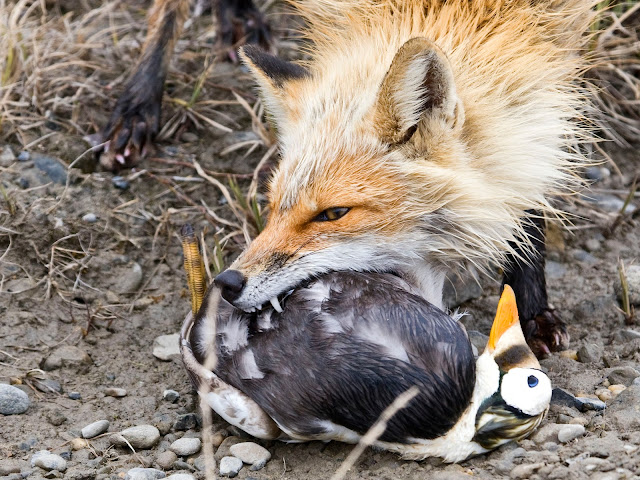
THE ALASKA RED FOX
A small to medium-sized fox, with long and slender legs and pointed muzzle, and
long brush-like tail. A large-sized subspecies of North American Red Fox, with large and long
tail, long fur and small ears, very similar to abietorum (British Columbian red fox). Pelage is golden fulvous, long and full on
neck and anterior part of back, almost forming a ruff, shorter and coarser on posterior part of
back and rump, where it is more grizzled in color.
Throat and chest are white. Face and head
grizzled fulvous and buffy, strongly rusty on top of nose and around eyes, paler on cheeks and
forehead. Muzzle slender and pointed, white on upper lip. Ears relatively large, pointed, erect,
black backed, and usually white inside. Tail is very long, thick and bushy, fulvous like back, with
the usual admixture of black hairs, and a white tip. Black, silver and cross color phases are
common. Females are smaller than males.
Reproduction and behavior
- Gestation: 52 days.
- Young per birth: 3-7.
- Weaning: 90 days.
- Sexual maturity: 12 months.
- Life span: around 3 years in nature, up to 10 in captivity.
- Breeding season: February and March.
Breeding dens are usually dug in sandy knolls with sunny south-facing exposures; at each den there are a series of about half a dozen large burrows, from 20 to 25 cm in diameter, connected with each other underground. The female is confined to the den during the pups’ first few days of life, depending on her mate to supply food, but soon begins to leave the den for short periods to forage on her own. By their third month, the pups begin learning to hunt. In early winter the young disperse to seek out a new home range. Social behavior: mated pairs, females and males may remain as breeding pairs for several years and work cooperatively to rear offspring.
Diet and interaction with the environment
Their diet consists in small mammals (mice, voles, shrews, snowshoe hare, common muskrats), and birds (ptarmigan) in winter. In summer it also eats eggs of ground-nesting ducks, marsh birds, grasses and sedges, and berries. On the Arctic tundra, it feeds mainly on collared lemming, tundra voles and Arctic ground squirrels.
Their main predators are the lynx, wolf, coyote, wolverine, eagles and perhaps bears. They are solitary and territorial, with territories averaging 2.9 km2 in size, often bounded by rivers or other natural barriers. Related Foxes do not share home range resources, and females occupy smaller ranges.
Habitat:
They are native to Canada and United States. Found in most of
Alaska, northern and central Yukon Territory, and Northwest Territories.
It occurs throughout most of mainland Alaska and on several far eastern Aleutian Islands. They are uncommon along the mainland of
southeastern Alaska north of the Taku River, and rare along the southern mainland.
Commercial Fox farming resulted in the introduction of Red Foxes
to many North Pacific islands. It occurs throughout the Yukon.
They inhabit a wide variety of habitats, ranging from tundra to boreal
forests, steppe and temperate deserts. In Alaska they prefer
riparian drainages in the mountains and foothills, coastal plains
and river valleys. In the Yukon they inhabit white spruce forests,
subalpine areas of willow and soapberry, and alpine tundra. Small
numbers have begun to inhabit the Arctic tundra of the far north
over the last century, where they compete with the
Arctic Fox; in
these areas, they have been observed digging arctic foxes from
their dens and killing them. The expansion of the coyote’s range
has affected its distribution.
Failing to reach the range of the westernmost Alaskan islands has allowed the conservation of two subspecies of Arctic foxes in the Bering Sea (the
Bering Island Arctic Fox and
Pribilof Arctic Fox). Even so, it can be assumed that some subspecies of arctic foxes similar to these may have disappeared from the islands closer to mainland Alaska with the arrival of the red fox in the area.

Conservation status: Least Concern. Populations in Alaska and the Yukon are considered large and
abundant. It was the first furbearer to be raised in captivity for pelt
production.
Physiognomic information:
- Body length: 56-82 cm
- Tail length: 35-45 cm
- Height: 35-50 cm
- Weight: 2.7-6.8 kg
- Skull: 14.5 cm
Taxonomy:
The North American red foxes have been traditionally considered either as subspecies of the Old World red foxes, Vulpes vulpes, or subspecies of their own species, Vulpes fulva. Due to the opinion that North American red foxes were introduced from Europe, all North American red foxes have been seen as conspecific with Vulpes vulpes; however, genetic analyses of global red fox haplotypes indicates that the North American red foxes have been genetically isolated from the Old World populations for 400,000 years, prompting possible application of Vulpes fulva to all North American red foxes.
Castello (2018) has formalized treatment of Vulpes fulva as a separate species from the Old World Vulpes vulpes. In 2014, Mark J. Statham among others released a study that supports Vulpes fulva as a separate species from the Old World Vulpes vulpes. More about the Vulpes vulpes fulva and Vulpes fulva discussion:

Gallery:
Due to the similarity in appearance between North American Red Foxes, some of the images may be erroneous. That's why I haven't found any videos about this subspecies either, if you think you have any image or video of the Vulpes fulva abietorum let me know in the comments or contact me on any of my social networks (@etzharai).









.png)








No hay comentarios:
Publicar un comentario